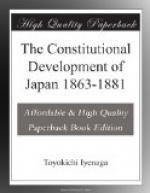The Council of Kuges was occasionally convened by the order of the Emperor. It was composed of the princes of the blood, nobles, and courtiers. The Council of Daimios was now and then summoned either by the Emperor or by the Shogun. It was composed mostly of the Daimios. These councils were like the Witenagemot of England, formed of the wise and influential men of the kingdom. As the Daimios had far more weight in the political scale of the realm than the Kuges, so the council of the Daimios was of far more importance than that of the Kuges. But it must not be understood that these councils were regular meetings held in the modern parliamentary way; nor that they had anything like the powers of the British Parliament or of the American Congress. These councils of Japan were called into spasmodic life simply by the necessity of the time. They were held either at the court of Kioto or that of Yedo, or at other places appointed for the purpose. The Kuges or Daimios assembled rather in an informal way, measured by modern parliamentary procedure, but in accordance with the court etiquette of the time, whose most minute regulations and rules have often embarrassed and plagued the modern ministers accredited to the court of the Emperor. Then these councils proceeded to discuss the burning questions of the day, among which the most prominent was, of course, the foreign policy. The earliest instance of the meeting of the Council of Kuges was immediately after the news of Perry’s arrival had reached the court of Kioto. “Upon this,” says the author of Genje Yume Monogatari, “the Emperor was much disturbed, and called a council, which was attended by a number of princes of the blood and Kuges, and much violent language was uttered.”
From this time on we meet often with the record of these councils.[10] A native chronicler records that on the 29th day of the 12th month of 1857 “a meeting of all Daimios (present in Yedo) was held in the Haku-sho-in, a large hall in the castle of Yedo. The deliberations were not over till two o’clock on the morning of the 30th.”
Soon after this the Emperor ordered the Shogun to come to Kioto with all the Daimios and ascertain the opinion of the country. But the Shogun did not come, so the Emperor sent his envoy, Ohara Sammi, and called the meeting of the Daimios at Yedo in 1862, in which the noted Shimadzu Saburo was also present.
In 1864 the council of Daimios was again held, and Minister Pruyn, in his letter to Mr. Seward, bears witness of the proceeding: “It is understood the great council of Daimios is again in session; that the question of the foreign policy of the government is again under consideration, and that the opposite parties are pretty evenly balanced."[11]
From this time the council of Daimios was held every year, sometimes many times in the year, till the Revolution of 1868. These examples will suffice to show the nature and purpose of these councils of Kuges and Daimios. Let us next consider how these councils originated.




